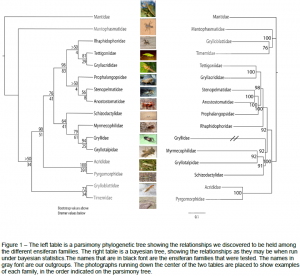Jessica Jensen and Dr. Michael Whiting, Biology
Ensifera is an insect suborder within the order Orthoptera that includes insects such as katydids and crickets. The evolutionary history of Ensifera is largely unknown, and there is no consensus on the phylogenetic relationships among families within Ensiera. A large part of this is due to inadequate character sampling (insufficient number of families or number of DNA loci used) in previous studies. This study was the most character-rich phylogenetic analysis of Ensifera to date, and we proposed a new hypothesis of relationships between ensiferan families.
We based our study on complete mitochondrial genomes and sequences from four nuclear loci (18S, 28S, Histone 3, and Wingless). We used twelve taxa representing all six ensiferan superfamilies: Grylloidea, Hagloidea, Rhaphidophoroidea, Schizodactyloidea, Stenopelmatoidea, and Tettigonioidea and ten of twelve families. By collecting and comparing DNA sequences from members of each of these families, we were able to propose a hypothesis of the relationships for families within Ensifera and create a phylogeny.
Results supported a monophyletic Ensifera. We placed Gryllidae as sister to Gryllotalpidae, which is in agreement with most of the current literature. We placed Rhaphidophoridae as sister to Tettigoniidae and Gryllacrididae. We placed Prophalangopsidae as sister to Stenopelmatidae and Anostostomatidae. Shizodactylidae is placed as sister to Myrmecophilidae, which is sister to Gryllidae and Gryllotalpidae.
The interesting aspect of these results is that some of the familial placements do not match up with the hypotheses in the current literature. Rhaphidophoridae as sister to Tettigoniidae and Gryllacrididae is a new development, as is the placement of Myrmecophilidae as sister to Gryllidae and Gryllotalpidae. These insights will be of great assistance to those studying Ensifera and seeking to validate the true evolutionary relationships between these families.
Further areas that need research would be to replicate this study, using different nuclear loci or different species within the individual families. The evolutionary history of an organism is subject to a great amount of individual interpretation and can change based on personal preference in which computer analyzing programs to use, and one study is not sufficient to make any hard predictions.
I presented my findings on three occasions. The first was at the Entomological Society of America’s conference in San Diego, California. My presentation was in the form of a poster. I also presented my findings in a powerpoint presentation at the Utah Council for Undergraduate Research at Weber State University. I lastly presented my data at BYU’s Undergraduate Scientific Poster competition and was awarded with third place. All of these experiences were excellent, educational, and extremely beneficial for my education.

